Some Guitar Pedals I Have Built
Created and maintained by Paul Marossy, Tonemeister Extraordanaire
Last updated 6/23/12
I have been on a
quest the last couple of years to find the sound I have been looking for. In
the process, I have become a sort of "tonemeister". I have decided
that I just don't care for digital effects (there are some that are really great,
too). I feel that they are just not as warm and most of them leave something
to be desired. Analog is just better sounding. Period. (Just my opinion of course)
The only exceptions I will make is some digital delays and some digital reverbs
sound really heavenly. So one day, I decided to try building some of my own
and tailoring them to fit my tonal requirements.
That aside, after learning some basic electronics and how to read schematics,
it's not that hard to build you own guitar effect pedal. There are a lot of
good sites such as http://www.geofex.com or http://www.diystompboxes.com that are a wealth of information. There
are also forums where you can post questions. These are good places to obtain
schematics for projects you may want to build. You can also find sound clips
for all these pedals, too. Beware! , once you build one, you may not be able
to stop!
Below are some pictures and brief descriptions of each of my pedals, in the order that I built them. Some of them required me to design my own PCB layouts, since at the time I made them, there was no PCB layout available. I did this for the Black Cat OD-1 clone, Shaka Tube, Jawari, Amber Boost, Chaos, Blue Clipper, Easy Drive and AMZ Mini-Booster. I also redesigned the Ross Distortion, BSIAB and Boutique Fuzz Face PCB's to make them smaller or to fit in my enclosure better. The Blue Magic, Smash Drive, Obsidian Rev. D, Bulldog Cabinet Simulator, TS808 Tube Screamer and Orange Squeezer were made from the PCB's available at their respective websites. I built the Metal Simplex and Phuncgnosis with perfboard. The Three-Legged Dog was built using the perfboard layout at RunOffGroove.com. I lost track of the rest, but most of them were built using PCBs.
 |
Here is the first pedal I ever built, in
October 2001. This is a clone of the Black Cat OD-1 , also known as the
Custom Audio Electronics "Freddie Fuzz". This one uses a cascaded OP275 dual opamp circuit, and is touch sensitive. It also cleans up pretty well when the guitar volume is turned down. It has quite a lot of gain. I built it because Scott Henderson (one of my favs) used it for a while, and I really liked his tone. So I decided to build it just for fun. I still use it all the time. |
||||||||||||
 |
This is Joe Davisson's Obsidian Overdrive,
Rev D. It uses three 2N7000 MOSFETS and has quite a
lot of gain. Sounds like a Boss Metal Zone, but is a
little warmer sounding. It faithfully reproduces that
80's metal sound. It also sounds great for fusion lead
type stuff. Unfortunately, it is plagued by a lot of
white noise (hiss). The transistor version of this
circuit sounds a lot better from what I hear. |
||||||||||||
 |
This is Joe Davisson's " Amber
Boost " It uses a TS271 CMOS single opamp, with two 2N7000 MOSFETs acting as clipping diodes. It is a dynamic sounding pedal, with lots of gain. Good pedal for a driving rock sound. Nice sounding circuit. |
||||||||||||
 |
This is Tim
Escobedo's "Jawari", an electric sitar
simulator. It's simple to build, and uses one JFET, a few caps and resistors and a 10K:10K audio transformer. It sounds neat when used with a high gain pedal, such as a Boss Metal Zone. I added an internal tone control to shape the tone to suit my musical style. |
||||||||||||
 |
This is a Ross
Distortion clone with some of my own additions. The box
is actually from my second ever project, the original
circuit got trashed because I didn't like it. It uses a single opamp and clipping diodes. I added pre and post distortion tone controls and a switch that allows me to switch between symmetrical and asymmetrical clipping, which is accomplished by 1N4148 silicon diodes and 1N34 germanium diodes. |
||||||||||||
 |
This is Aron Nelson's " Smash
Drive " with the Marshall-style tone stack. It uses a LM386 audio opamp, and a very few other parts. High gain and aggressive sounding. I added an input cap switch, and tweaked the low, mid and high tone caps to my liking. Good sounding pedal for in-your-face type of stuff. |
||||||||||||
 |
This a variant of the Black Cat OD-1
circuit. I added clipping diodes in the feedback loop of the second stage of the opamp. I incorporated a switch to allow the use of 1N4148 silicon diodes, 1N34 germanium diodes or no clipping diodes. The silicon diodes make it sound more fuzzy, but the pedal doesn't sound as great as I hoped. It does sound decent in certain contexts, though. |
||||||||||||
 |
A friend gave me a bunch of these old transceivers in the hopes that I may be able to use them for something. I figured out a way to recycle the enclosures by cutting them down, and making a removable bottom piece. The original enclosure measured 4-1/8"x2-7/8"x2-1/4" high. After my modifications, it measures 1" high. A useful size for making stompboxes. Many of my newest pedals are made from one of these enclosures. | ||||||||||||
 |
This is
the Blue
Magic ", the first project of 2003. It uses a BS170 MOSFET that pushes a J201 JFET into distortion. It is a medium gain pedal, touch sensitive and smooth sounding. It's a very nice sounding circuit, similar to but better (in my opinion) than the original Ibanez TS9 Tube Screamer. |
||||||||||||
 |
This is
Ed Guidry's " BSIAB " (Brown
Sound In A Box).
It uses five J201 JFET's for a medium-high gain distortion. Sounds like a cranked lower wattage Marshall. The more I use it, the more I like it. I designed my own PCB for this project which is much more compact than other ones I have seen. And, here is a soundclip which was recorded by and posted on someone else's site at one time. |
||||||||||||
 |
This one
is based on Aron Nelson's " Shaka
Tube " circuit. I called it the "Bulldog". It uses a TL072 opamp and a 12AX7 preamp tube with a bias control. Has a nice bluesy sound, and you can change the tone by changing the type of tube. Enclosure is 4"x5"x1.5". It plugs into a wall receptacle and is operated by 120VAC through a wall wart transformer to 12.6VAC, then converted to DC with a rectifier/470uF filter caps. Power jack is on the back. I also drilled ventilation holes on both sides of the enclosure. |
||||||||||||
 |
This is
Mark Hammer's " Chaos ". I called
it the Hammerhead 'cause it's mean!
It uses a cascaded dual opamp (I used a JRC4558D) , and has clipping diodes in both feedback loops! This one utilizes both symmetrical and asymmetrical clipping. I has mondo distortion and good sustain. The most interesting thing is how the tone control works. It goes from a mild crunch to over-the-top head banger distortion with just a turn of the tone control. This is proving to be one of my most versatile distortion pedals. I designed my own PCB for this project. |
||||||||||||
 |
This is
Craig Anderton's " Volume
Pedal De-Scratcher ". This one is very useful, because I am tired of scratchy volume pots!! |
||||||||||||
 |
Ever see a sewing machine foot pedal at the thrift store and wonder if you could do something with it for your guitar? Here is something you do with what seems like a useless piece of junk... | ||||||||||||
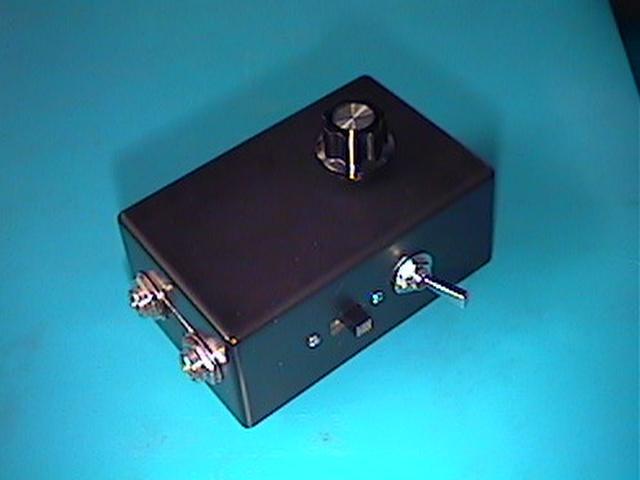 |
This one
is based on Dan Armstrong's " Blue
Clipper " circuit from the 70's. I called it
the " Belt
Drive ", because it clips on your belt. Honestly, it's not
very practical, but I thought it would be fun to try to
get everything in such a small enclosure... It uses a TL071 single opamp with 1N914 silicon clipping diodes on the output. A very basic tried and true circuit with nice tone. It cleans up well with the guitar's volume control. This one clips on your belt and is very portable. My Nokia 5160 cell phone is bigger than this is! It was a challenge getting all that stuff to fit in this 3"x2"x1.6" enclosure. I recently put the circuit into a Hammond 1590 enclosure. |
||||||||||||
 |
This is
Ambrose Chapel's " Bulldog
Cabinet Simulator ". This one is designed for going straight into a mixing console, and emulates a speaker cabinet. A lot of stuff is packed inside this small enclosure. It measures 3"x2"x1.1" and is black plastic. It sounds good with something like a Blue Clipper before it. It uses a TL082 dual opamp, and I installed the blend pot as shown on the schematic. There are some mods that can also be done to this circuit. I guess a have a pair of bulldogs now... |
||||||||||||
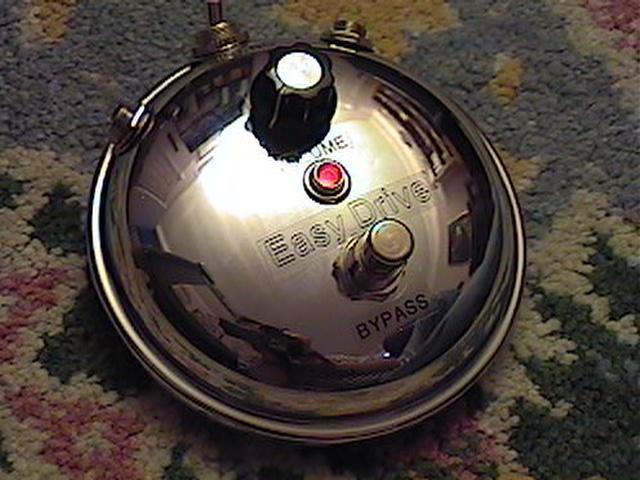 |
This is
Joe Davisson's " Easy
Drive ". This one uses a single 2N3904 transistor and a pair of clipping diodes. It has an amazing amount of distortion for a one trick, uh, transistor pony. I got the enclosure from a thrift store for 75 cents. It is apparently the lid to some sort of kitchen gadget. I just barely got everything to fit inside of it. I used the bottom part of a tuna can for the bottom cover. At one time, this was the channel switcher for my Seymour Duncan Convertible amp, but I remodeled it. Please pardon our dust... |
||||||||||||
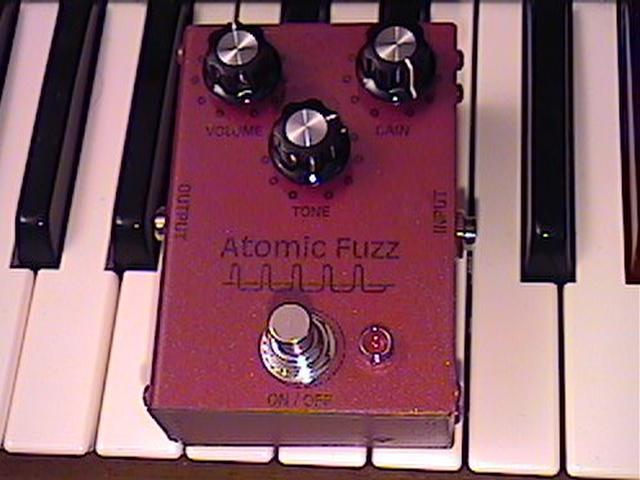 |
This is
Howie's " Metal
Simplex ". This one uses two 2N3904 transistors and a red LED acting as a clipping diode, producing asymmetrical clipping, which is pleasing to the ear. To me, it really sounds more like a higher gain overdrive pedal as opposed to a metal pedal. It has lots of harmonics, and it sounds nice. The circuit lends itself to mods of all sorts. Tweaking the tone cap can change the sound a lot, and using higher gain transistors like some 2N5089's would turn it into a metal monster. |
||||||||||||
 |
This is
Jack Orman's " AMZ Mini-Booster ". This one uses two J201 JFET's. It is a lower gain overdrive, akin to the glorified Ibanez Tube Screamer. It works well for when you want to add a little bite to your sound, but not be too overpowering. I added a tone control and a gain boost switch, which takes the 10uF cap (C6) on the source of Q1 in or out of the circuit (see schematic). There is not a dramatic difference between on and off positions, but it is noticeable, and I have found it to be useful. |
||||||||||||
 |
Here is
Gary Burchett's creation, the " Three-Legged
Dog
". An interesting little circuit using a CD4049UBE CMOS Hex Inverter chip. I built it per the perfboard layout Gary drew up. If you build this one, beware! It squeals like crazy on a low battery! I always use an AC adapter, so I don't think I will ever have that problem... |
||||||||||||
 |
This is
the " Boutique
Fuzz Face ". This is the PNP negative ground version. It is a pretty good sounding fuzz face circuit, and is the fuzziest of the circuits I have built thus far. When doing chordal type stuff, it will produce a nice chunky, fat sound. I used sockets for the transistors so I could try different types until I found the ones that I like best, some NOS germanium Raytheon T59247 audio type. Read my Fuzz Face Notes for more on transistors. I chose to have the bias pot as an external screwdriver adjustment, for variety of reasons. |
||||||||||||
 |
This is an Ibanez TS808 Tube Screamer clone built per the layout at www.GeneralGuitarGadgets.com. A classic stompbox with a good tone. What else can be said? | ||||||||||||
 |
This is
the " JFET
Audio Mixer ". This is something that you can use when you want to mix two different distortions for example. |
||||||||||||
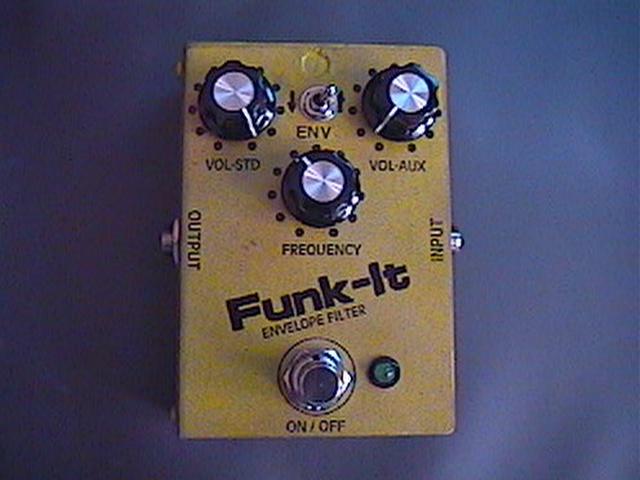 |
This is Tim
Escobedo's "Phuncgnosis", which uses an
envelope filter circuit, more commonly known as an
"auto-wah". On this circuit, you can switch the filter up or down. I used an LF353 opamp which has a wide bandwidth. I am still working on the best way to manipulate the frequency range a little bit. I like to use this for a different sound when I am soloing. I used a switch on the back of the enclosure for switching between the regular input and the auxiliary input to the circuit. |
||||||||||||
 |
This is the EA
Tremolo, a very smooth sounding 100% solid state
tremolo that appeared in Electronics Australia magazine
in 1968. It sounds great! I built this one using the hand
drawn PCB layout at Nabke's site. I used two 2N3904 transistors and one J201 FET. If you like tremolo, give this one a try. Here is my PCB layout. Note: One invidual wrote to me and informed me that the 2N3904 transistors as shown on the PCB layout needed to be rotated 180 degrees. This was corrected as of 1/14/05.< |
||||||||||||
 |
This is Joe Davisson's "Blackfire" , another high gain distortion pedal. It uses five 2N5089 high gain, low noise transistors. The transistors I used in mine had an Hfe of over 800. I also added a modified Marshall-style tone stack, I changed the cap values to increase the bass response to get more low end. I'm thinking about maybe adding a switch to bypass the tone stack, just for kicks. | ||||||||||||
 |
This is Dan Armstrong's Orange
Squeezer , a well loved compressor designed in the
70's. This one was on hold for a while while I was
waiting to find some suitable JFETs to complete this
project. I ended up using MPF102's. This is a nice
sounding compressor, and it is basically "plug and
play". The original unit didn't even have a level
control. When using high output humbuckers, this circuit
distorts a little bit, but most compressor circuits are
prone to this as well. I used the PCB layout found at GeneralGuitarGadgets.com |
||||||||||||
 |
This is the vibrato circuit from
"Laurier's Handy Dandy Circuits". I'm still
tweaking this one some, the circuit as shown on the
schematic has a low output compared to the bypassed
signal. I think this can be solved by putting a
transistor section at the ouput to boost the signal a
little bit. That aside, it sounds nice and the overall effect is pleasant. To my ears, it's really more of a rather somewhat subtle tremolo effect than a true vibrato. It does have a little bit of a pitchshifting effect that is just barely detectable at times. Changing the cap values in the oscillator section results in faster or slower rates depending on cap sizes used. |
||||||||||||
 |
This is my modified DOD YJM 308 clone, which is the Yngwie Malmsteen signature preamp overdrive. I'm not a big Yngwie fan, but the circuit looked interesting enough to build. I messed with the input and output cap values a little bit to my own tastes and used 1N34 germanium diodes instead of 1N4148 silicon diodes, which mkaes the distortion a little smoother. I believe this is a slightly modified DOD 250 circuit. The YJM308 schematic linked above appears to have one error: the 100 ohm resistor should be between the power supply and the opamp power supply rather than in series with 22K resistor at the voltage divider network. This is how I built mine. | ||||||||||||
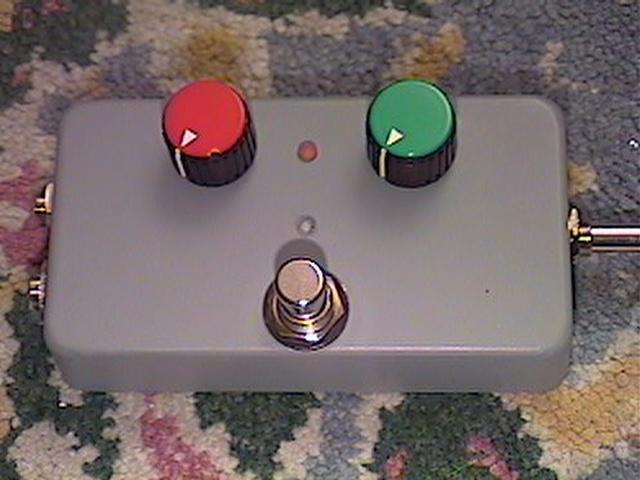 |
This is a FET Buffered A/B Box that I designed to be able to use two guitars with only one amplifier input without unplugging cords, like an acoustic and an electric for example. I used a bi-color status indicator, an LED that switches between green and red. The red knob controls the channel that is active when the LED is red and the green knob when the LED is green. It is possible to get everything inside of a Hammond 1590B enclosure with some careful planning. | ||||||||||||
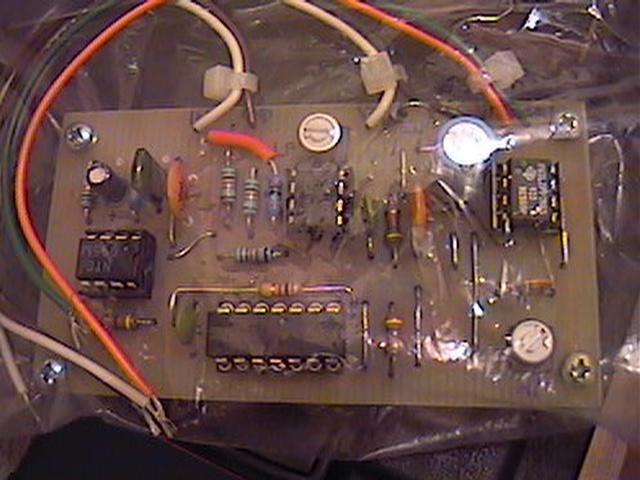 |
In the
works is an ambitious design of my own, what I call the
" Guitar-Synth-In-A-Box ". This is a complicated circuit, but if I can get it to work, it will hopefully get some Pat Metheny guitar synth type sounds. Shown here is one of the two PCB's required. |
||||||||||||
 |
Here is a tube overdrive of my own design, something that I call the
" PJM Tube Overdrive ". This is a variation of Aron Nelson's Shaka Tube circuit. Follow the link above for more information. |
||||||||||||
 |
Here is Doug Hammond's "Highway 89". This is a nice little circuit combining a Brain May style boost at the input, a boutique style tone control and the output section of Joe Davisson's "Blackfire". Nice, thick, bluesy tone that lends itself to many different styles. I built it on perfboard. I recycled the 2-piece RadioShack enclosure that my very first build was in at one time. Here is a picture of the inside.< | ||||||||||||
 |
Here is Joe Davisson's "Shocktave". This is a cool octave circuit that is kind of like a harmonizing distortion pedal. Listen to the sound clip at Joe's page, and I'm sure you will think so, too. | ||||||||||||
 |
Here is a simple thing I designed that I call "Solo-Pro". It's just simply a box that switches between two preset volume levels. I wanted something that would give me some kind of volume boost for solos. I used a bi-color LED so that I can keep track of which setting it is on. Here is the schematic. | ||||||||||||
 |
Here is a simple thing I designed that I call "Looper". It's just simply a box that switches between two pairs of jacks, basically a signal router that can be used to switch between my pedal board and a digital effects processor. I used a bi-color LED so that I can keep track of which setting it is on. It is in a plastic Hammond Mfg. project enclosure. I shielded the inside with some self-adhesive aluminum foil. I used the box once for a circuit and then gutted it. I had three existing holes drilled in it on the top surface. To fix that, I created some graphics with AutoCAD, glued that to the top of the enclosure. I covered it with some clear plastic, which is the type plastic that protects the posters in those poster board frames. I don't know what type of plastic it is, but it you're careful drilling it, it makes a nice protective cover. (To cut it, you just score it well and use some pliers to carefully snap it at the score lines) This got fastened to the top of the enclosure with four small screws. Here is a wiring diagram. | ||||||||||||
 |
This is an MXR Phase 45 clone. It is built per the layout at www.tonepad.com
except for substituting the FETs with J201s, using a 200K trimpot instead of 250K, and using 0.047uF caps instead of the 0.05uF caps specified on the schematic. This circuit has a very nice sound that can sound much like a flanger depending on how the trimpot is set. One mod that could be done to this circuit is to make that trimpot a regular pot that could be adjusted from the exterior of the enclosure. (Now I think of this?!) Here is a little study on how this phaser affects a sine wave as viewed with an oscilloscope. |
||||||||||||
 |
This is Aron Nelson's " Shaka Express", made with the PCB layout found at www.geofex.com. This is another high gain distortion pedal with some cool features like a "bite" control that has a large affect on the quality of the distortion. The switch at lower left is for a mod I incorporated into the circuit which is based on Ed Rembold's suggestion for the T3 arrangement. Here is a few more pictures: Interior, Switch Wiring, LED Wiring, LEDs From Exterior. Here is a waveform study on how the bite control affects the sound. | ||||||||||||
 |
This is
the Shaka Tube in a
Hammond 1590BB enclosure. This is essentially the same thing as my "Bulldog" shown above, but redesigned from scratch to fit into a smaller enclosure. Here is a waveform study on this circuit comparing my first build with this one. |
||||||||||||
 |
This is
clone of the original ProCo RAT. I used the PCB layout available at
tonepad.com. It is essentially built exactly per the tonepad layout except that I used a CA3130 Bimos MOSFET opamp in place of the 741 opamp. This seems to give the circuit a little smoother sounding distortion to my ears. As you can see, this circuit can be built into a much smaller enclosure than the real deal. |
||||||||||||
 |
This is a simple passive A/B switch box that I built. It seems like you can always find a use for one of these... | ||||||||||||
 |
Not really a stompbox, but here is my scratchbuilt wah pedal . The circuit used is a clone of the Colorsound inductorless wah, using a twin-T type circuit. | ||||||||||||
 |
Taking my first scratchbuilt wah pedal a step farther, this is my second DIY pedal project . The circuit used is from the Maestro Boomerang, one of the few inductor based wah circuits that isn't a straight copy of the CryBaby circuit. This one sounds very good and it works very well. | ||||||||||||
 |
This is a clone of the Way Huge Electronics "Red Llama", built per the PCB layout found here . The circuit is based on the CD4049UBE hex inverter chip. | ||||||||||||
 |
Here is Craig Anderton's Frequency Booster, which I think is a useful thing to have around for recording and stuff. I used a 3P4T rotary switch to give me an option of 0.1uF, 0.022uF, 0.01uF and 0.0047uF caps which will boost frequencies from the low mids (200Hz) to the upper mids (4kHz). With distortion, it kind of acts like a harmonic exciter. All in all, I think it's pretty cool. A schematic & PCB layout can be found here . | ||||||||||||
 |
This is Hammer's "The Crank", which is a nifty booster circuit using a very clever design. I reused the enclosure of the YJM 308 clone, which I wasn't that happy with. Here is my PCB layout for this project. | ||||||||||||
 |
This is a clone of the Tychobrahe
Parapedal which I have never heard of before, but WOW! this thing is a very unique
sounding type of wah. It's in
my second DIY wah
shell. I used some JRC4558 opamps
that I had lying around and an Alps 100K dual pot that I got from RadioShack. I soldered
a 12K resistor in parallel with each pot to make them approx. 10K. I'll switch it out for
a "real one" at a later date. I got
the schematic
and
the PCB layout
from
www.geofex.com
.
|
|
 This is what I have dubbed the "Dual Rectifier In A Box", which is otherwise known as
the Dr. Boogey. It's basically a solid state emulation of a Mesa Boogie Dual Rectifier Solo Head amp - it sounds very large ("open") and has
huge amounts of gain. It's built in an
LMB Heeger
Model LMB #CR 531 enclosure measuring 3"x5-1/2"x1-1/4" and is constructed out
of sturdy 0.050" thick aluminum. The box is in its original pre-painted state. The knobs come from a cheapo Crate bass amp
that I parted out. It was a tight fit to get everything in there - check out
this picture
,
this picture
and
this picture
. I also added a
hi/lo gain switch
, which switches a 1M resistor in
parallel with the 1M gain pot. | I built this monster per the PCB layout here which is laid out per this schematic . It's a great alternative to something like the Boss Metal Zone.  This is the first thing I have built in about six months - Tim
Escobedo's "T.M.K.", an unruly type of fuzz box similar
to the Z. Vex Fuzz Factory. |
It's simple to build, and uses one dual opamp, and several clipping diodes in various configurations.  This is the Jordan Boss Tone
, a fuzz circuit similar somewhat similar to a Vox Tone Bender.
I used a PCB of my own design, a 100K pot on the output and a switch for the diode limiter section on the
output. This circuit is very responsive to picking dynamics and has a wide range of sounds
as I built it. The paint job is my first attempt at airbrushing an enclosure.
|
 This is John Hollis'"Crash Sync", which is basically the front end of an MXR Blue Box with
a 555 based oscillator synchronisation circuit at the output. Very cool circuit for those who want something
off the wall. The buzzy synthesizer-ish tones range from nasal-ly wah type sounds to a cool sounding
sounding octave down distortion. |
The enclosure is hand painted by none other than myself (any resemblence to ColorSound products is purely coincidental). I used the PCB layout from Hollis' website. It's a very tight fit in a Hammond 1590B box, but I managed to get it all in there.  This is the Schaller Bow Wow Yoy Yoy
, a German made wah pedal circuit. It has a different sound than the usual CryBaby tone. I designed a
PCB
that is a drop-in replacement for the GCB-95 CryBaby PCB. In this picture, it is installed in a standard CryBaby shell.
|
|  |
This is an ADA Flanger clone in an enclosure designed and made by myself. After working on several original great sounding ADA Flangers for other guitarists, I decided that I had to have one of these units for myself. For more info on this build, Click Here . | 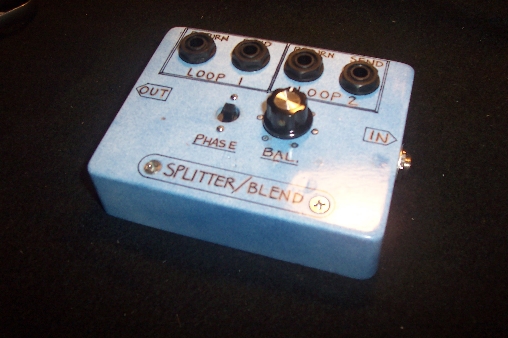 |
This is the R.O.G. Splitter Blend , which consists of two buffered parallel effects loops with a blend control and phase polarity switch which allows for phase matching of the effect loops. |  |
This is the R.O.G. English Channel
, which is an FET simulation of the Vox AC-30 Top Boost. It sounds really good, perfect for getting the tones that the TS808 Tube Screamer clone doesn't quite capture. For this build, I re-used the enclosure from my Blackfire build which didn't really excite me that much. |
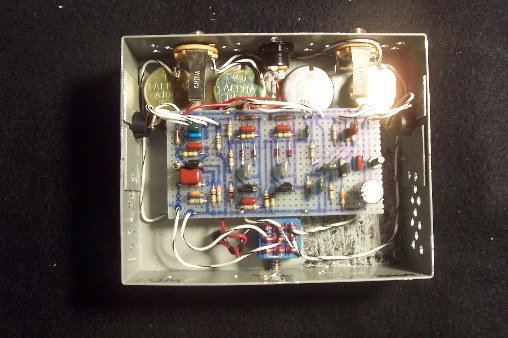 |
This is a Russian Big Muff Pi clone with most of the mods from the Premier Guitar mods page . I built this one on perfboard so I could try various ideas. I think it's pretty cool with the dual tone controls. You can get a pretty wide range of sounds from it. I housed it in an old enclosure from a project I built a few years ago. |  |
This is a clone of a boutique MOSFET overdrive pedal. The maker will remain anonymous out of respect, but I give him credit where credit is due - this circuit is very well designed. It really does sort of respond like a tube amp with the way that it interacts with the guitar. It's also cool because it's kind of like having two pedals in one. I will recommend this product to anyone looking for a great tone. |  |
Here is a clone of the Boss Slow Gear made from the info found at This Page . This is a cool effect that I find suits my style very well. On this one I've used one the enclosures from one of my very first DIY projects which has had three other circuits in it over the years. I just used a gold paint pen for the graphics on this one. I did the part substitutions recommended at the website regarding C2, R14, R16 & TR1, and used a 2SK30A FET. |
 |
Black Cat Ring Modulator that I made using PCB that I drew up from real example I had in hand at the time. | ||||||||||||
 |
Buffalo Pfuz clone. I recreated the unique enclosure using wood. You can see video of that HERE . | ||||||||||||
 |
This is a more conventional pedal version of the Bullog Cabinet Simulator shown above. | ||||||||||||
 |
This is a scratchbuilt replica of Colorsound Wah Wah stamped steel enclosure, but made out of wood. See can see more about it HERE . | ||||||||||||
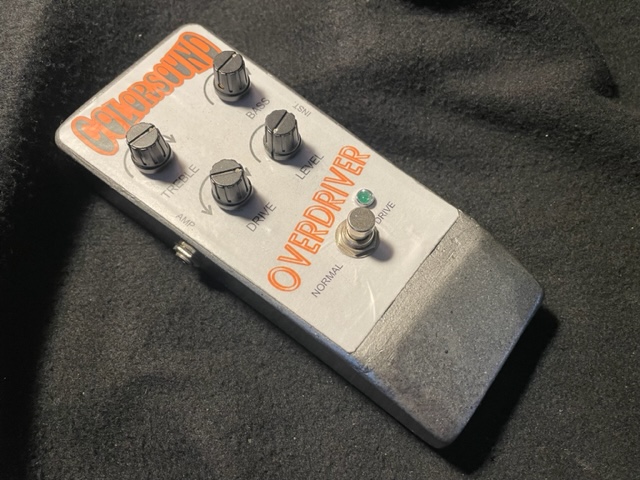 |
Colorsound Overdriver in a quasi-replica enclosure made of wood. | ||||||||||||
 |
Here is a Jordan Bosstone with the "trombetta mod". | ||||||||||||
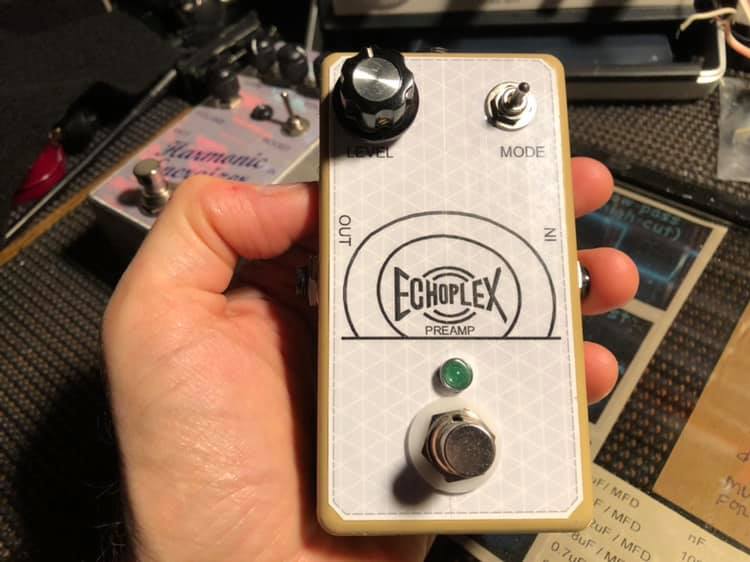 |
Here an Echoplex preamp. I made it using an Aion FX PCB. | ||||||||||||
 |
Here is a Systech Harmonic Energizer clone, which is a workalike of the original unit made famous by Frank Zappa. I used PCB that is available at the Aion FX website. | ||||||||||||
 |
Here an Ibanez OD-855 clone. This was the precursor to the famous Tube Screamer. I made this using a PCB which is available at the Aion FX website. | ||||||||||||
 |
Here is a Klon Centaur clone. I made this one using a PCB which is available at the Aion FX website. | ||||||||||||
 |
Here is a Lab Series L5 preamp. I think is the most complex thing I've ever built! I made it using PCB which is available at the Aion FX website. I made my own enclosure using a combination of wood and aluminum. | ||||||||||||
 |
This is a vibrato I made that actually IS a vibrato, at certain settings. It kind of mimics the old Magnatone guitar amps, but it does not sound as big or lush (because it's mono). It does not sound bad though. I used the schematic found HERE . It's not a diffult build but the hardest part of it is getting the DIY LDR section right. | ||||||||||||
 |
This is the ROG "Condor". It's a simulation of a 4x10 speaker cabinet. It sounds very Fender-ish to my ears. | ||||||||||||
 |
This my Shaka Tube redo. I like this version much better! More about that HERE . | ||||||||||||
 |
This is the venerable Stratoblaster. It's in the tin that my two-tone oscillator once used. | ||||||||||||
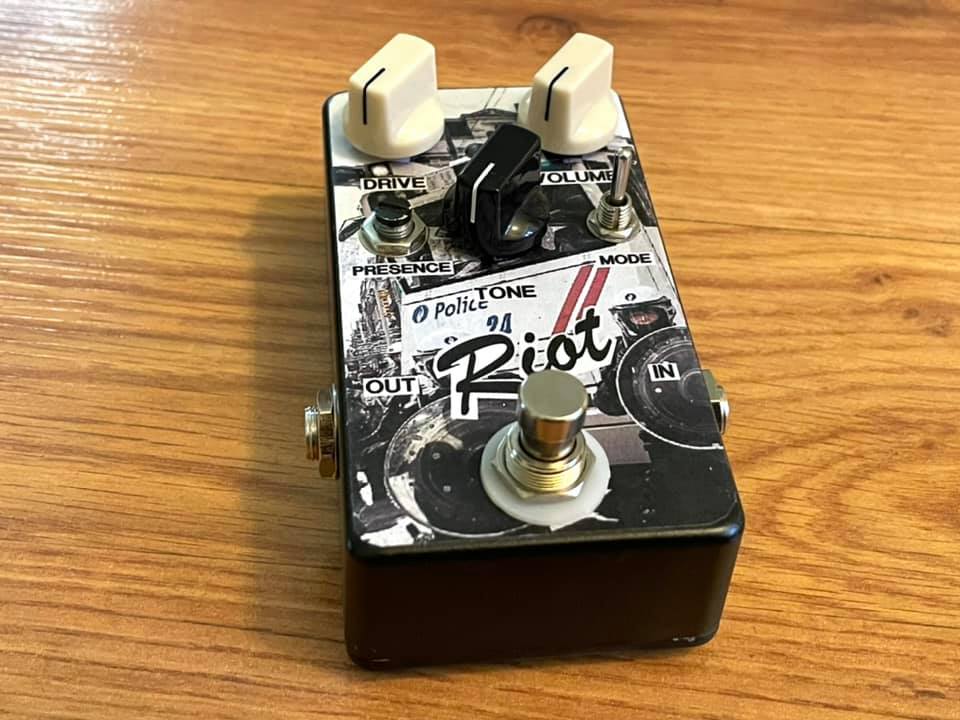 |
This a Suhr Riot clone using a PCB which is available at Aion FX . Also more about it HERE . | ||||||||||||
 |
This is an FET simulation of the Soldano Supercharger GTO. It uses currently hard to get J201s. Sorry, can't share a schematic because it was a design project for a boutique pedal manufacturer and I signed a NDA on it, but it does sound great. I use it often! | ||||||||||||
 |
This is a PT2399 based delay pedal design that I added modulation to and a few other tweaks. Sorry, can't share any more info on this one... signed a NDA on it. | ||||||||||||
 |
This is the Craig Anderton Ultra Fuzz. It was too over the top for me but it was an interesting build nonetheless. | ||||||||||||
 |
This is the "Valvetizer". I had a bit of trouble with it... can't find a power supply that it likes, so still a work in progress. |
There is probably more that I have built that aren't listed here. I'll have to look thru my collection sometime and see what I may have missed.
A DIY Guitar Effects Prototyping Board